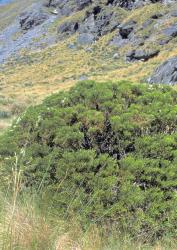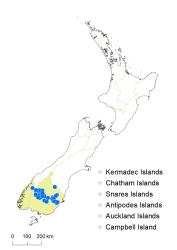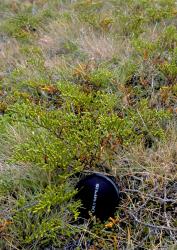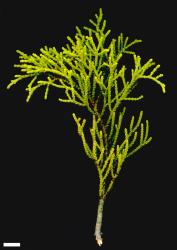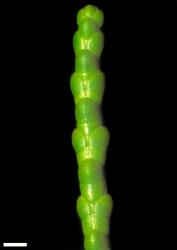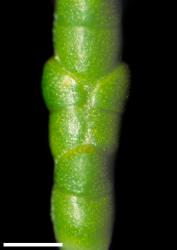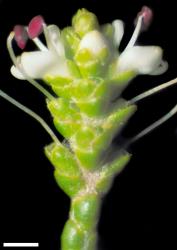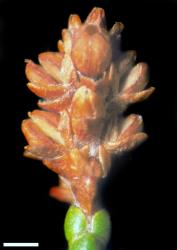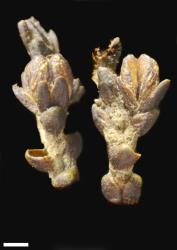- Taxon
- Gallery
- ≡ Hebe propinqua (Cheeseman) Cockayne & Allan, Trans. New Zealand Inst. 57: 41 (1926)
- ≡ Leonohebe propinqua (Cheeseman) Heads, Bot. Soc. Otago Newsl. 5: 9 (1987)
- = Veronica cupressoides var. variabilis N.E.Br., Gard. Chron. ser.3, 3: 20, Fig. 5 (1888)
- = Veronica propinqua var. major Cockayne, Man. New Zealand Fl., ed. 2, 820 (1925)
- ≡ Hebe propinqua var. major (Cockayne ex Cheeseman) Cockayne & Allan, Trans. New Zealand Inst. 57: 41 (1926)
Spreading low or rounded bushy whipcord shrub to 1 m tall. Stems ascending to erect, eglandular-pubescent; hairs bifarious above leaf axils and in deep grooves between connate leaf bases. Leaf bud indistinct, its outer leaves fully grown, diverging, opposite-decussate, appressed but not covering the usually well-marked node above, coriaceous, broadly ovate to deltoid, 0.7–1.8 mm long, 1.4–3.2 mm wide, dull to more or less glossy green above and beneath; veins not evident; surfaces glabrous; margin shortly ciliate or ciliolate, entire; apex obtuse; base broad, connate in pairs and encircling stem; petiole absent. Inflorescence a terminal spike, 3–9 mm long; flowers crowded, 4–10 per inflorescence, all bisexual; bracts opposite-decussate and connate, deltoid; pedicels absent. Calyx lobes 4, the anterior connate at the base or to about ⅓-way, sub-acute to acute, or acuminate by inrolling of margins, 2.0–2.5 mm long, sub-equal, eglandular-ciliate with a few short glandular hairs as well. Corolla 4.5–6.0 mm diameter; tube white, 1.5–2.1 mm long, = calyx, eglandular-hairy inside; lobes 4, white, sub-erect to recurved, unequal, elliptic to oblong, 2–3 mm long, sub-acute to rounded; nectar guides absent. Stamen filaments white, 3.5–4.5 mm long; anthers magenta. Style glabrous, 2.7–5.8 mm long. Capsules latiseptate, sub-acute to obtuse, glabrous, 1.5–3.0 mm long, 1.4–2.1 mm at widest point. Seeds ellipsoid, flattened, slightly wrinkled, pale brown, 0.6–1 mm long.
Among whipcord hebes, V. propinqua is distinguished by a combination of characters. The plants have calyx lobes that are free for most of their length, leaves that do not overlap so that the well-marked nodal joints are exposed, and leaves that are not longitudinally ribbed.
Plants of V. annulata, V. armstrongii, V. ochracea, and V. salicornioides all differ in having anterior calyx lobes that are usually fused to their apex, and their nodal joints, although exposed, are generally obscure.
Plants of V. hectorii and V. tetragona have shorter internodes, which means their leaves overlap and obscure the well-marked nodal joints.
Finally, V. lycopodioides and V. poppelwellii have distinctive ribbed, longitudinal veins on their leaves.
South Island: Fiordland, Otago, Southland (Livingstone Mountains, Thomson Mountains, Eyre Mountains, The Remarkables, Hector Mountains, Garvie Mountains, Slate Range, Mt Benger, Mid Dome, Umbrella Mountains, Lammermoor Range, Rock & Pillar Range, Mt Ida, Mt Maungatua).
Penalpine grassland and sub-alpine scrub. Recorded elevations range from 580 to 1500 m.
Flowers: October–February; fruits: December–March, persisting longer.
2n = 40 (see Bayly & Kellow 2006, as Hebe propinqua).
Veronica propinqua is classified in V. subg. Pseudoveronica sect. Hebe and informally in the “Flagriformes” group, also known as “whipcord hebes” (Albach & Meudt 2010; Bayly & Kellow 2006). V. propinqua is probably related to the other whipcord hebes, especially those that share its chromosome number, 2n = 40 (i.e., V. hectorii, V. tetragona).



